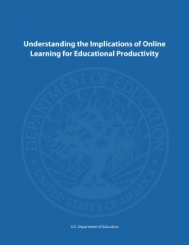Promoting Grit, Tenacity, and Perseverance - U.S. Department of ...
Promoting Grit, Tenacity, and Perseverance - U.S. Department of ...
Promoting Grit, Tenacity, and Perseverance - U.S. Department of ...
Create successful ePaper yourself
Turn your PDF publications into a flip-book with our unique Google optimized e-Paper software.
Draft<br />
practices for fostering these competencies. Educators should also be aware <strong>of</strong> the trade-<strong>of</strong>fs in<br />
terms <strong>of</strong> technology requirements <strong>and</strong> flexibility in design <strong>and</strong> use by teachers.<br />
Need for Structural <strong>and</strong> Systemic Supports, Advocacy, <strong>and</strong> Parental Support<br />
While the evidence is growing that there are actionable best practices <strong>and</strong> programmatic<br />
approaches to promoting grit, tenacity, <strong>and</strong> perseverance in many settings, there remain<br />
tremendous barriers to implementation. A ubiquitous theme in our interviews <strong>and</strong> literature<br />
review is the need for structural <strong>and</strong> systemic supports. Some <strong>of</strong> the major barriers cited in the<br />
interviews were:<br />
• Accountability-driven school cultures emphasizing gains on st<strong>and</strong>ardized tests may be<br />
inconsistent with the practices necessary to promote these qualities.<br />
• Many teachers feel they already have too many st<strong>and</strong>ards to cover without adding what can<br />
seem to them to be more content. In most schools, short school periods are densely packed<br />
with content st<strong>and</strong>ards. Students may not have the time to seek assistance, reflect, or iterate<br />
on their work.<br />
• Many teachers, particularly in urban districts, have as many as 160 students per day. This can<br />
be an insurmountable barrier to allowing teachers to provide the constructive personalized<br />
feedback <strong>and</strong> guidance that can be critical to students’ perseverance.<br />
• Most teachers do not have access to pr<strong>of</strong>essional development with explicit guidance for how<br />
they should integrate these practices <strong>and</strong> approaches into their own unique settings with their<br />
particular student populations. Most preservice <strong>and</strong> pr<strong>of</strong>essional development programs do<br />
not currently explicitly address these competencies.<br />
• Many school cultures have not implemented <strong>and</strong> supported practices to promote valuing <strong>of</strong><br />
these types <strong>of</strong> qualities <strong>and</strong> some believe they are the responsibility <strong>of</strong> the parent rather than<br />
the school.<br />
Our informants had several specific recommendations. Most centrally, it is essential to provide<br />
pr<strong>of</strong>essional development for administrators <strong>and</strong> teachers, as well as curriculum materials <strong>and</strong><br />
technological supports. Also, as time <strong>and</strong> resources for thoughtful reflection, feedback, <strong>and</strong><br />
iteration can be an important support for perseverance, other potentially high-leverage strategies<br />
may be restructuring school days to have longer periods <strong>and</strong> increasing school staffing so that<br />
teachers have a more manageable number <strong>of</strong> students. Outreach <strong>and</strong> inclusion <strong>of</strong> parents <strong>and</strong><br />
other community members also can provide important bridges.<br />
Conclusion 4: In this accountability-driven culture, there are a wide range <strong>of</strong> systemic <strong>and</strong><br />
structural barriers that prevent broad implementation <strong>of</strong> many best practices <strong>and</strong> programs.<br />
84
















